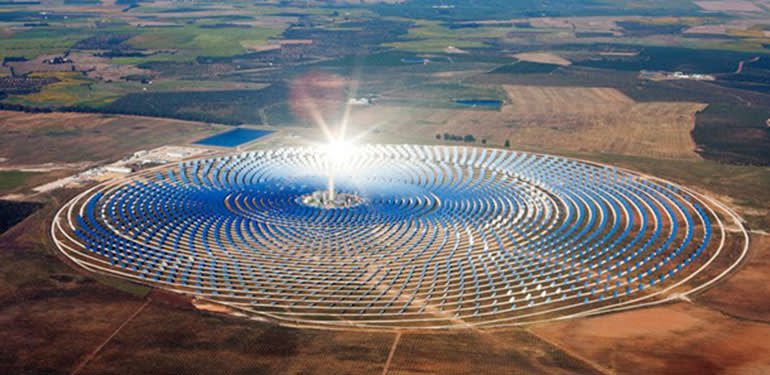File under interesting
New company Xlinks has worked out that Solar in the UK is limited by our Northerly aspect and rainy days. So they have come up with a neat solution, put the solar panels closer to the Equator and run a long cable back to the UK.
The Morocco – UK Plan
The Xlinks Morocco-UK Project will be a new electricity generation facility entirely powered by solar and wind energy combined with a battery storage facility. Located in Morocco’s renewable energy rich region of Guelmim Oued Noun, it will cover an approximate area of 1,500km2 and will be connected to Great Britain via 3,800km HVDC sub-sea cables.
This project will generate 10.5GW of zero carbon electricity from the sun and wind to deliver 3.6GW of reliable energy for an average of 20+ hours a day. This is enough to provide low-cost, clean power to over 7 million British homes by 2030. Once complete, the project will be capable of supplying 8 percent of Great Britain’s electricity needs.
Alongside the consistent output from its solar panels and wind turbines, an onsite 20GWh/5GW battery facility provide sufficient storage to reliably deliver each and every day, a dedicated, near-constant source of flexible and predictable clean energy for Britain, designed to complement the renewable energy already generated across the UK.
When domestic renewable energy generation in the United Kingdom drops due to low winds and short periods of sun, the project will harvest the benefits of long hours of sun in Morocco alongside the consistency of its convection Trade Winds, to provide a firm but flexible source of zero-carbon electricity.
In effect this will provide close to baseload power levels. – Clever.
Technology
The Morocco-UK Power Project will be powered by a wind and solar farm, approximately 1,500km2 in size, within Morocco’s Guelmim Oued Noun region. The wind farm will utilise the reliable Trade Winds in the region, which are driven by the temperature differential between the Atlantic Ocean and African continent. The wind speed at the generation site increases throughout the late afternoon and evening, ensuring power can be delivered to Britain during times of peak demand.
The solar photovoltaic (PV) farm will cover approximately 200km2 and track the sun from east to west throughout the day. This will not only maximise the output of the solar farm, but it will also increase the output early in the morning and late in the afternoon, providing the most consistent generation profile to Britain. Although the project will benefit from the most advanced solar panel designs, they will work in the same way as the ones installed on people’s houses, throughout the UK, and existing generation sites within Morocco. However, the increased solar resource means that the same PV panels generate approximately three times more power in Morocco than they would in the UK. Importantly, the solar panels will generate as much as five times more power from January to March than those in the UK, which will help to keep the lights on and homes warm in Britain throughout the coldest winter days.
Battery Storage
The project will benefit from a 20GWh/5GW battery facility, which will provide confidence that the power generated can be stored and delivered to Britain at the times when it is most needed. This will primarily be provided by Lithium-ion batteries like those used in electric cars, home battery systems and utility scale storage projects throughout the world.
These batteries will also allow Xlinks to install more solar PV systems and wind generation, which will maximise the use of the subsea transmission system. Delivering an average of 20+ hours a day at full power reduces the cost of sending per unit of electricity delivered to Britain. It also provides National Grid with the confidence that the project will be powering Britain even at times of low wind and low solar output across Northern Europe.
Cable
To allow for electricity transfer, Xlinks is installing a transmission system from the generation site in Morocco to Britain, most of it across the ocean. The power generated will be transmitted directly to Britain without connection to the Moroccan, Spanish, Portuguese, or French transmission networks. This provides confidence that no matter what is happening on any electricity networks, Britain will have exclusive access to reliable power from the Moroccan wind and solar resources.
How big is this?
Xlinks claim that the project will generate 10.5 GW of power and deliver 3.6GW of energy for 20 hours / day. About the same size as Nuclear Power Station.
- The UK currently has eight operational nuclear power stations, which supplied 18% of total electricity supply in 2018.
- Nuclear installed capacity peaked at 12.7 GW in 1995, with the opening of Sizewell B – the last nuclear reactor to be opened in the UK. In this year, nuclear accounted for more than a quarter of total electricity supply.
- Construction is underway for a new 3.2 GW nuclear power plant at Hinkley Point C, with the developer forecasting that Reactor One will begin commercial operations at the end of 2025.
When and How?
The government uses a contract-for-difference funding mechanism for renewables and big infrastructure projects. Xlinks says it’s seeking 48 pounds a megawatt-hour for the power it would send to Britain, just over half the price the government agreed to for Hinkley.
We’re approaching this as remote generation so this is solely for the U.K. energy market,” Xlinks founder and Chief Executive Officer Simon Morrish said in an interview. “It’s coming from an area which has completely different weather patterns, and is not correlated, so it provides enormous amounts of resiliency to the U.K. energy system.”
The company has been talking to the government about the project as it prepares for its CFD application.
The firm plans to build at least two factories to manufacture the cables needed, which will be quicker than waiting for an existing company to construct them, Morrish said. The project is fully funded up to financial close, which will be in 2023.
Xlinks wants to start laying the cable in 2025, and targets finishing the first half in 2027 and the rest by 2029.
Learn more – Xlinks

